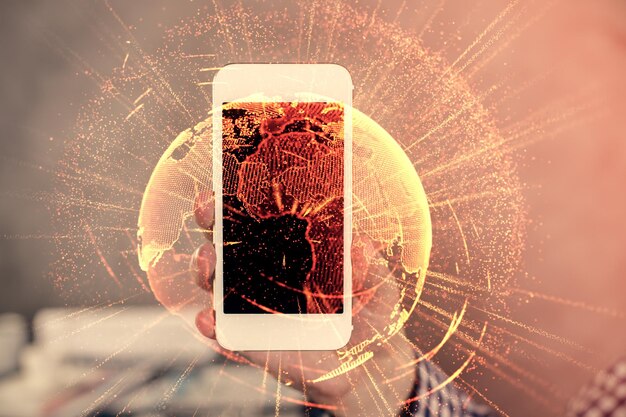Can AI Predict Viral Trends? A 2025 Data Experiment

Can AI Predict the Next Viral Trend? An Experiment Using January 2025 Data explores the potential of artificial intelligence in forecasting emerging viral trends by analyzing data from January 2025, offering insights into future marketing strategies and content creation.
Will AI algorithms accurately foresee the next viral sensation? This article delves into Can AI Predict the Next Viral Trend? An Experiment Using January 2025 Data, revealing the possibilities and limitations of using artificial intelligence to forecast what will capture the internet’s attention.
Decoding Viral Potential: AI’s Role in Trend Forecasting
The allure of predicting viral trends has always fascinated marketers and content creators. But can artificial intelligence truly offer a glimpse into the future of online culture? Let’s explore how AI might be harnessed to identify and anticipate what’s next.
The Power of Data Analysis
AI’s strength lies in its ability to process massive datasets. By analyzing social media engagement, search queries, and content performance, AI algorithms can identify patterns and correlations indicative of emerging trends.
Machine Learning Models for Trend Prediction
Several machine learning models can be employed for predicting viral trends, including time series analysis, natural language processing, and deep learning. Each model offers unique advantages in capturing different aspects of viral content dynamics.
- Time Series Analysis: Identifies cyclical patterns and seasonal trends in historical data.
- Natural Language Processing (NLP): Analyzes text data to understand sentiment and topic popularity.
- Deep Learning: Employs neural networks to learn complex relationships and make predictions based on vast amounts of data.
AI isn’t a magic bullet, but a powerful tool for analysis and anticipation. It allows businesses to be one step ahead of competitors.

January 2025 Data: A Snapshot of the Future
Focusing on data from January 2025 provides a specific timeframe to explore AI’s predictive capabilities. What insights can be gleaned from this particular period, and how do they inform our understanding of future trends?
Key Data Points and Metrics
Several key data points and metrics are crucial for AI-driven trend forecasting: social media engagement rates, search query volumes, news article mentions, and influencer activity. Analyzing these metrics in combination provides a comprehensive view of emerging trends.
Identifying Early Signals of Viral Potential
AI algorithms can be trained to identify early signals of viral potential by detecting sudden spikes in engagement, unusual hashtag usage, and the emergence of novel content formats. These signals can serve as leading indicators of an impending viral trend.
AI works on identifying anomalies. Sudden variations in data patterns may be the key to unlocking important information needed to identify upcoming trends.
The Experiment: Setting Up the AI Model
Designing an effective AI model for trend prediction requires careful consideration of various factors. From data selection to algorithm training, each step plays a crucial role in determining the model’s accuracy and reliability.
Choosing the right tools and setting up the environment requires a considerable skill set. This is also very important to make sure that AI is effective in prediction.
Data Preprocessing and Feature Engineering
Before feeding data into the AI model, it must be preprocessed to remove noise and inconsistencies. Feature engineering involves selecting and transforming relevant variables to optimize the model’s performance.
Training and Validation Techniques
The AI model is trained on a historical dataset to learn patterns and relationships between input features and viral outcomes. Validation techniques are used to assess the model’s accuracy on unseen data and fine-tune its parameters.
- Cross-Validation: Divides the data into multiple subsets for training and validation.
- Hyperparameter Tuning: Optimizes the model’s parameters to achieve the best performance.
- Regularization: Prevents overfitting by penalizing complex models.
Analyzing AI’s Predictions: Accuracy and Limitations
Assessing the accuracy of AI predictions is essential to understanding its true potential. While AI can offer valuable insights, it’s important to recognize its limitations and potential biases.
Evaluating Prediction Accuracy
Prediction accuracy can be evaluated using various metrics, such as precision, recall, and F1-score. These metrics provide a quantitative assessment of the model’s ability to correctly identify viral trends.
Addressing Bias and Ethical Considerations
AI models can inherit biases from the data they are trained on, leading to skewed predictions. It’s crucial to address these biases and ensure that AI is used ethically and responsibly.
AI is not a perfect tool, and human oversight is still necessary when making important decisions.
Viral Content in 2025: Predicted Trends
What specific viral trends does the AI model predict for 2025? By analyzing various data points, the model may identify emerging themes, content formats, and topics that are likely to capture the internet’s attention.
Emerging Themes and Topics
The AI model may predict the resurgence of certain themes, such as sustainability, mental health, or virtual reality. It may also identify emerging topics related to technological advancements, social movements, or cultural phenomena.
Potential Content Formats
The AI model may suggest the rise of specific content formats, such as short-form videos, interactive experiences, or augmented reality filters. These formats may align with evolving user preferences and technological capabilities.

Human Creativity vs. AI Predictions: Striking a Balance
While AI can provide valuable insights, human creativity remains essential in crafting truly compelling viral content. Striking a balance between AI-driven insights and human ingenuity is key to success.
The Role of Human Intuition
Human intuition can complement AI predictions by identifying subtle nuances, emotional connections, and cultural shifts that algorithms may miss. Human creators can leverage AI insights to inform their creative process, but should not rely on them blindly.
Creative Collaboration: AI as a Partner
AI can serve as a creative partner, providing creators with data-driven insights, generating novel ideas, and automating repetitive tasks. By embracing AI as a collaborative tool, creators can unlock new levels of innovation and efficiency.
The future is about collaboration between humans and machines. In summary, humans are creative and AI is very technical. Together they can collaborate to achieve incredible results.
| Key Point | Brief Description |
|---|---|
| 🚀 AI & Data Analysis | AI’s power lies in analyzing large datasets for emerging trends. |
| 📊 January 2025 Data | Focusing on a specific timeframe to explore AI’s predictive accuracy. |
| 🤖 AI Model Limitations | Acknowledging potential biases and ethical considerations. |
| 🎨 Human Creativity | Balancing AI insights with human intuition for compelling content. |
Frequently Asked Questions
▼
No, AI cannot guarantee perfect predictions. However, it can identify patterns and signals that increase the likelihood of a trend becoming viral, offering valuable insights.
▼
Social media engagement, search query volumes, news articles, and influencer activity are all crucial data points. Combining them offers a comprehensive view.
▼
Carefully curate your data for diversity, regularly audit your model’s predictions for fairness, and consider incorporating human oversight in the process.
▼
Potential concerns include manipulating public opinion, exacerbating existing biases, and creating echo chambers. Responsible AI use requires transparency and accountability.
▼
Human intuition can identify subtle nuances that AI may miss, fostering originality. Collaboration enhances emotional connection and cultural relevance giving content the viral edge.
Conclusion
As we venture further into the age of artificial intelligence, its capacity to foresee viral trends becomes increasingly relevant. While perfect accuracy remains elusive, the insights derived from AI, combined with human creativity, can unlock new frontiers in content creation and marketing strategies, shaping the future of viral content.





